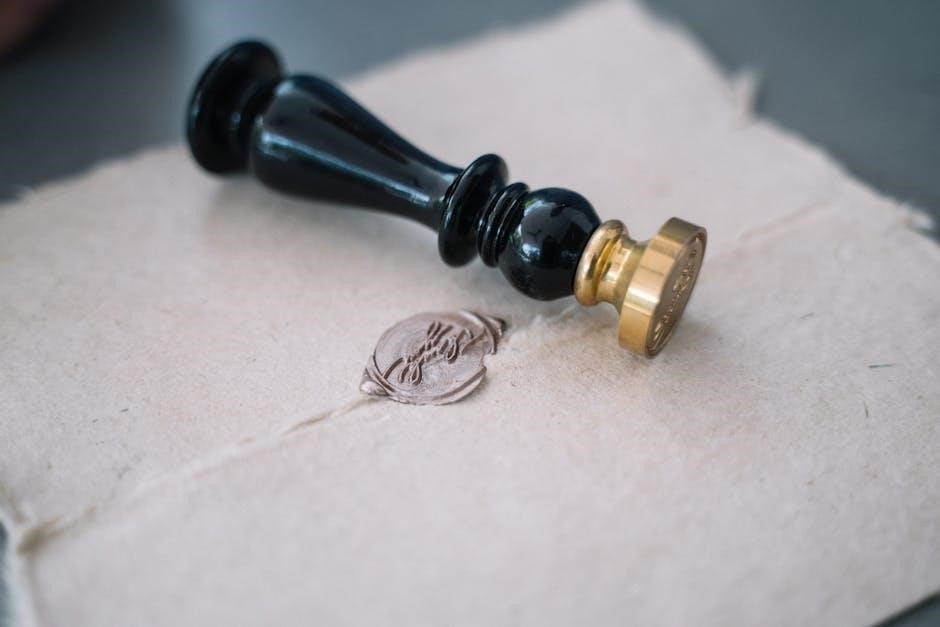Welcome to the PWK Carburetor Manual‚ your comprehensive guide to understanding‚ installing‚ and optimizing PWK carburetors for peak performance. This manual covers essential tuning‚ maintenance‚ and troubleshooting tips to ensure your engine runs smoothly and efficiently. Whether you’re a seasoned mechanic or a DIY enthusiast‚ this resource will help you master the PWK carburetor system.

1.1 Overview of the PWK Carburetor
The PWK carburetor is a high-performance‚ float-type carburetor designed for motorcycles‚ ATVs‚ and off-road vehicles. Known for its adaptability and ease of tuning‚ it features adjustable components like the pilot jet‚ main jet‚ and needle system. Its design ensures precise air-fuel mixture control‚ delivering optimal power across the throttle range. Popular in racing and stock applications‚ the PWK carburetor is praised for its durability and responsiveness‚ making it a favorite among enthusiasts and professionals alike. This overview provides a foundation for understanding its operation and benefits.
1.2 Importance of Proper Tuning and Maintenance
Proper tuning and maintenance of the PWK carburetor are crucial for optimal engine performance‚ fuel efficiency‚ and longevity. Incorrect settings can lead to issues like backfiring‚ poor idle‚ or reduced power. Regular maintenance‚ such as cleaning the air filter and inspecting fuel lines‚ ensures smooth operation. Adjusting components like the pilot jet‚ needle‚ and main jet requires precision to avoid damaging the engine. This manual provides detailed guidance to help users achieve the perfect balance‚ ensuring their PWK carburetor performs reliably and delivers peak performance across all throttle ranges.

Components of the PWK Carburetor
The PWK carburetor consists of key components like the air filter‚ throttle valve‚ pilot jet‚ needle system‚ main jet‚ float bowl‚ fuel inlet‚ slide‚ and spring‚ each playing a vital role in fuel delivery and engine performance.
2.1 Air Filter and Intake System
The air filter and intake system are critical for ensuring clean air enters the PWK carburetor‚ preventing dust and debris from clogging internal components. A dirty or clogged air filter can lead to poor engine performance‚ backfiring‚ and fuel delivery issues. Regular cleaning or replacement of the air filter is essential to maintain proper airflow and prevent contamination. The intake system should be inspected for blockages or damage‚ as any restriction can disrupt the air-fuel mixture‚ leading to idle problems and reduced power output. Proper maintenance ensures optimal performance and longevity of the carburetor.
2.2 Throttle Valve and Cable
The throttle valve and cable system in the PWK carburetor controls airflow and fuel delivery based on rider input. The throttle valve regulates the carburetor’s opening‚ directly affecting engine speed and performance. The cable connects the throttle grip to the carburetor‚ ensuring smooth and precise control. Proper adjustment of the throttle cable is crucial to avoid issues like hesitation or difficulty maintaining consistent speed. If the cable is too loose‚ it may not open fully‚ while excessive tension can cause sticking. Regular inspection and lubrication of the cable and throttle valve ensure optimal performance and responsiveness.
2.3 Pilot Jet and Needle System
The pilot jet and needle system in the PWK carburetor plays a critical role in delivering the correct air-fuel mixture at low throttle openings. The pilot jet regulates fuel flow during idle and low-speed operation‚ while the needle system fine-tunes the mixture as the throttle opens. Proper adjustment of the pilot jet and needle height ensures smooth idle‚ responsive acceleration‚ and prevents issues like backfiring or hesitation. If the pilot jet is too small‚ the engine may run lean‚ causing poor performance. Regular inspection and adjustment of this system are essential for maintaining optimal engine operation and fuel efficiency.
2.4 Main Jet and Jet Needle
The main jet and jet needle are vital components responsible for delivering the correct air-fuel mixture at higher throttle openings. The main jet regulates fuel flow into the carburetor‚ while the jet needle fine-tunes the mixture by adjusting its height within the needle jet. Proper sizing and installation of the main jet ensure optimal performance‚ preventing issues like bogging or backfiring. The jet needle’s position is critical for smooth power delivery across the throttle range. Always refer to the manual for specific specifications and adjustment guidelines to ensure precise tuning and reliable engine operation.
2.5 Float Bowl and Fuel Inlet

The float bowl and fuel inlet are essential for maintaining consistent fuel flow to the carburetor. The float bowl stores fuel‚ while the fuel inlet connects to the fuel source. Proper float height adjustment ensures the correct fuel level‚ preventing overflow or starvation. A clogged fuel inlet or incorrect float setting can lead to poor engine performance. Regular cleaning and inspection of these components are crucial for reliable operation. Always refer to the manual for specific adjustment procedures to ensure optimal fuel delivery and engine efficiency.
2.6 Slide and Spring
The slide and spring in the PWK carburetor regulate airflow and mixture delivery. The slide moves vertically‚ controlled by the spring‚ to adjust the carburetor’s venturi size. This affects the air-fuel mixture at different throttle positions. A stiffer spring delays slide movement‚ while a softer spring allows easier opening. Proper spring tension ensures smooth throttle response and prevents lean or rich conditions. Regular cleaning and inspection of the slide and spring are crucial to maintain precise airflow and optimal engine performance. Adjustments should be made carefully to avoid disrupting the carburetor’s balance.
Installation Guide
This section provides step-by-step instructions for installing the PWK carburetor‚ including pre-installation checks‚ mounting‚ fuel line connections‚ throttle cable adjustment‚ and initial setup for optimal performance.
3.1 Pre-Installation Checks

Before installing the PWK carburetor‚ ensure all components are clean and free from damage. Inspect the air filter‚ fuel lines‚ and intake system for any blockages or leaks. Verify that the throttle cable and linkage are properly aligned and functioning smoothly. Check the fuel tank for contamination or debris that could affect performance. Consult the manual for specific torque values and adjustments to ensure a secure and accurate installation. Proper preparation will prevent issues during setup and ensure optimal engine performance post-installation.
3.2 Mounting the Carburetor
Mounting the PWK carburetor requires precision to ensure proper alignment and a secure fit. Begin by aligning the carburetor with the intake manifold‚ ensuring the gasket is correctly positioned to prevent air leaks. Tighten the mounting bolts gradually in a star pattern to avoid warping the flange. Use the recommended torque specifications from the manual to ensure a tight seal without over-tightening. Once mounted‚ connect the throttle and choke cables‚ ensuring smooth operation. Double-check all connections for proper alignment and security before proceeding to the next steps.
3.3 Connecting Fuel Lines and Filters
Connecting the fuel lines and filters to the PWK carburetor is a critical step for proper fuel flow. Start by inspecting the fuel lines for any damage or blockages. Attach the fuel line to the carburetor’s fuel inlet‚ ensuring a secure connection with a fuel line clip. Install the fuel filter between the fuel tank and carburetor to prevent debris from entering the system. Use the correct size and type of fuel line to maintain optimal fuel pressure. Finally‚ check all connections for leaks by gently squeezing the fuel line while the engine is off.
3.4 Throttle Cable Adjustment
Proper throttle cable adjustment is essential for smooth engine operation. Begin by ensuring the throttle cable is free from obstructions and has minimal slack. Adjust the cable at the carburetor end by loosening the locknut and turning the adjuster until the throttle valve opens slightly when the throttle is pulled. Tighten the locknut and test the throttle response. If the engine hesitates or stalls‚ further fine-tuning may be needed. Ensure the idle speed is set correctly after adjusting the throttle cable for optimal performance.
3.5 Initial Setup and Syncing
After installation‚ begin with the initial setup by ensuring all components are properly connected and adjusted. Start by setting the idle speed to the manufacturer’s specifications using the idle adjustment screw. Next‚ synchronize the throttle valves to ensure even airflow across all cylinders. Adjust the synchronization screws until the engine runs smoothly at idle and throughout the throttle range. Fine-tune the air-fuel mixture by adjusting the pilot and main jets based on engine performance and spark plug readings. Proper syncing ensures optimal power delivery and prevents uneven engine operation.

Tuning the PWK Carburetor
Tuning the PWK carburetor is crucial for optimal performance. Adjust the air-fuel mixture‚ pilot jet‚ main jet‚ and needle settings to match your engine’s demands. Use spark plug readings to refine your setup and ensure smooth operation across the entire throttle range. This section provides a comprehensive guide to help you achieve the best results.
4.1 Understanding the Pilot System
The pilot system in a PWK carburetor is responsible for delivering fuel at low throttle openings‚ ensuring smooth idle and initial acceleration. It consists of the pilot jet and air screw‚ which regulate the air-fuel mixture. Adjusting the air screw clockwise enriches the mixture‚ while counterclockwise leans it. Proper pilot system tuning is critical to avoid issues like backfiring or rough idle. If the spark plug appears damp and black‚ it may indicate a rich condition‚ suggesting a smaller pilot jet is needed. Fine-tuning this system requires patience and careful observation of engine behavior.
4.2 Adjusting the Air-Fuel Mixture
Adjusting the air-fuel mixture in a PWK carburetor involves fine-tuning the pilot jet‚ needle system‚ and main jet to achieve optimal engine performance. The pilot jet affects low-throttle operation‚ while the main jet influences higher RPM ranges. Turning the air screw clockwise enriches the mixture‚ reducing backfiring‚ while counterclockwise leans it‚ potentially causing lean conditions. Spark plug readings are key: a light brown color indicates a proper mixture‚ while a dark‚ damp plug suggests a rich condition. Fine-tuning requires careful observation of engine behavior and gradual adjustments for precise calibration.
4.3 Fine-Tuning the Needle System
Fine-tuning the needle system in a PWK carburetor involves adjusting the needle height and clip position to optimize fuel delivery at mid-throttle ranges. The needle controls the fuel flow as the throttle opens‚ ensuring a smooth transition from the pilot to the main jet. If the engine bogs or hesitates‚ raising the needle (installing a thicker clip) enriches the mixture. Conversely‚ lowering the needle (thinner clip) leans it out. Observing engine behavior during acceleration helps determine the correct setting‚ ensuring seamless power delivery without over-fueling or starving the engine.
4.4 Optimizing the Main Jet
Optimizing the main jet ensures proper fuel delivery at high throttle conditions‚ preventing lean or rich running. A bogging engine or excessive smoke indicates a potential main jet issue. Test by gradually increasing or decreasing jet sizes during wide-open throttle (WOT) runs. A larger jet enriches the mixture‚ while a smaller jet leans it out. Spark plug readings can confirm if the jetting is correct. Always make incremental changes and test thoroughly to avoid over-correction. Proper main jet tuning is critical for peak power and engine longevity at higher RPMs.
4.5 Using Spark Plug Readings for Tuning
Spark plug readings are a vital diagnostic tool for tuning the PWK carburetor. A light brown color on the plug indicates a proper air-fuel mixture‚ while white or dark sooty deposits suggest lean or rich conditions. After test runs‚ inspect the spark plug to assess carburetor performance. Lean mixtures may cause a white‚ chalky appearance‚ while rich mixtures leave black‚ sooty deposits. Use these observations to adjust the main jet‚ pilot jet‚ or needle system accordingly. Accurate spark plug readings ensure optimal tuning‚ preventing engine damage and enhancing performance.

Troubleshooting Common Issues
Troubleshooting the PWK carburetor involves identifying symptoms like backfiring‚ rough idling‚ or poor acceleration. Check for air leaks‚ faulty jets‚ or clogged filters. Adjustments to the pilot or main jet may resolve rich or lean conditions. Spark plug readings can confirm mixture issues‚ while throttle cable adjustments ensure smooth operation. Regular maintenance and inspection are key to preventing and resolving common problems effectively.
5.1 Idle and Low-Throttle Problems
Idle and low-throttle issues with the PWK carburetor often manifest as rough idling‚ stalling‚ or hesitation. These problems can stem from a clogged pilot jet‚ incorrect air-fuel mixture‚ or improper throttle cable adjustment. Check the pilot jet for blockages and ensure it is clean. Adjust the air screw to achieve a smooth idle‚ turning it clockwise to richen the mixture or counterclockwise to lean it. If issues persist‚ inspect the throttle cable for slack or damage. Spark plug readings can also indicate whether the mixture is too rich or lean‚ guiding further adjustments for optimal performance.
5.2 Backfiring and Rich/Lean Conditions
Backfiring and rich/lean conditions in the PWK carburetor can indicate improper air-fuel mixture settings. A rich condition‚ where excess fuel is present‚ may cause sooty spark plugs and sluggish performance. Conversely‚ a lean condition‚ with too much air‚ can lead to backfiring‚ especially during deceleration. Check the main jet and pilot jet for blockages or incorrect sizing. Adjust the air-fuel mixture screw to balance the fuel flow. Ensure the throttle cable is properly synchronized to avoid sudden fuel delivery changes. Spark plug readings can confirm whether the mixture is too rich or lean‚ aiding in precise adjustments for smooth operation.
5.3 Fuel Starvation and Bogging
Fuel starvation and bogging in the PWK carburetor often occur due to insufficient fuel flow‚ particularly during acceleration. This can be caused by a clogged fuel filter‚ incorrect main jet sizing‚ or a malfunctioning float bowl. To address this‚ inspect the fuel filter and ensure it’s clean. Check the main jet for blockages or improper sizing‚ and adjust the float bowl level to maintain consistent fuel supply. Additionally‚ verify the throttle cable synchronization to prevent abrupt fuel interruptions. Proper diagnosis and adjustment can eliminate bogging and ensure smooth engine performance under varying conditions.
5.4 Air Leaks and Vacuum Issues
Air leaks and vacuum issues in the PWK carburetor can disrupt the air-fuel mixture‚ leading to poor engine performance. Common causes include faulty gaskets‚ loose connections‚ or cracked intake manifolds. Symptoms may include backfiring‚ rough idling‚ or a lean fuel condition. To diagnose‚ inspect all seals and connections for integrity. Use a vacuum gauge to identify leaks or apply a smoke test to locate the source. Addressing these issues promptly is crucial to restore proper carburetor function and maintain optimal engine performance.
5.5 Diagnosing Faulty Components
Diagnosing faulty components in the PWK carburetor requires a systematic approach. Start by identifying symptoms such as poor idle‚ backfiring‚ or reduced performance. Inspect the pilot jet‚ main jet‚ and needle for clogging or wear. Check the slide and spring for smooth operation and ensure the float bowl is functioning correctly. Use a compression test or vacuum gauge to pinpoint issues like air leaks or faulty seals. Replacing damaged or clogged parts with genuine components is essential to restore optimal performance and prevent further damage to the engine.

Maintenance and Cleaning
Regular maintenance is crucial for optimal PWK carburetor performance. Clean the carburetor thoroughly‚ inspect for wear‚ and replace damaged parts. Schedule routine checks to ensure longevity.
6.1 Cleaning the Carburetor
Regular cleaning of the PWK carburetor is essential for maintaining optimal performance. Start by removing the float bowl and soaking all components in a carburetor cleaning solution. Use a soft brush to scrub away stubborn deposits and grime. Rinse thoroughly with compressed air to ensure all passages are clear. Reassemble the carburetor carefully‚ ensuring all gaskets and seals are in good condition; Avoid using harsh chemicals that could damage rubber or plastic parts. A clean carburetor ensures proper fuel flow and prevents issues like bogging or poor idle. Always refer to the manual for specific cleaning instructions.
6.2 Replacing Worn or Damaged Parts
Replacing worn or damaged parts in your PWK carburetor is crucial for maintaining optimal performance. Start by identifying worn components such as the pilot jet‚ main jet‚ or needle. Use original or high-quality aftermarket parts to ensure compatibility and performance. Disassemble the carburetor carefully‚ taking note of all screws and clips. Clean the area around the damaged part before installation to prevent dirt from interfering. Reassemble the carburetor and adjust the settings as needed. Always refer to the manual for specific part numbers and torque specifications to avoid errors.
6.3 Regular Inspection Schedule
A regular inspection schedule is vital to ensure the PWK carburetor operates efficiently and reliably. Inspect the air filter every 100 hours of use and replace it every 500 hours or as needed. Check fuel lines for cracks or damage‚ and ensure all connections are secure. Examine the pilot jet‚ main jet‚ and needle for dirt or wear. Clean or replace these components if necessary. Also‚ inspect the throttle cable for smooth operation and proper adjustment. Regular inspections help prevent poor performance‚ backfiring‚ or fuel starvation. Always follow the manufacturer’s recommendations for maintenance intervals.

6.4 Storage and Winterization
Proper storage and winterization of your PWK carburetor are essential to maintain its performance and longevity. Before storing‚ drain the fuel system to prevent corrosion and add a fuel stabilizer if storing for extended periods. Clean the carburetor thoroughly with a carburetor cleaner and dry it completely. Apply a rust inhibitor to metal parts and store the carburetor in a dry‚ cool place. Avoid exposing it to moisture or extreme temperatures. For winterization‚ ensure all components are protected from freezing temperatures and condensation. Regularly inspect stored components before reuse to ensure optimal function.

Advanced Modifications and Upgrades
Explore advanced upgrades like jetting‚ needle adjustments‚ and slide modifications to enhance performance. Porting and polishing can improve airflow‚ while fuel enrichment devices boost power at high RPMs.
7.1 Upgrading Jets and Needles
Upgrading jets and needles in your PWK carburetor can significantly enhance performance by optimizing fuel flow. High-performance jets and needles are designed to improve throttle response and reduce bogging. Stainless steel needles offer durability and precise fuel metering. Main jets are available in various sizes to suit different engine modifications. Always select components based on your engine’s specific needs and operating conditions. Proper installation and tuning are crucial for optimal results. Refer to the manual for guidance on selecting and installing upgraded jets and needles for improved power delivery and efficiency.
7.2 Installing Aftermarket Slides
Installing aftermarket slides in your PWK carburetor can enhance performance by improving airflow and throttle response. These slides are designed to optimize power delivery‚ especially in high-performance or racing applications. Ensure compatibility with your carburetor model before installation. Remove the original slide‚ inspect the carburetor for debris‚ and install the new slide according to manufacturer instructions. Test the engine at various throttle positions to ensure smooth operation. Aftermarket slides can significantly improve mid-range and top-end power‚ making them a popular upgrade for enthusiasts seeking enhanced performance.
7.3 Porting and Polishing the Carburetor
Porting and polishing the PWK carburetor can significantly enhance airflow and performance by smoothing internal surfaces and enlarging critical passages. This advanced modification reduces turbulence‚ allowing for better fuel atomization and increased power output. Use specialized tools to carefully reshape and polish the carburetor’s intake and venturi areas. Ensure all edges are rounded to prevent sharp transitions that restrict airflow. For optimal results‚ consider consulting a professional or using a pre-ported carburetor kit. Proper porting and polishing can yield noticeable improvements in throttle response and overall engine efficiency‚ making it a worthwhile upgrade for high-performance applications.
7.4 Adding Fuel Enrichment Devices
Fuel enrichment devices enhance engine performance by delivering additional fuel during acceleration or high-load conditions. These devices‚ often installed in the carburetor’s inlet or vacuum ports‚ enrich the air-fuel mixture for increased power and responsiveness. Proper installation involves syncing the device with the carburetor’s airflow dynamics. Start with minimal adjustments and test under various conditions to avoid over-enrichment‚ which can lead to fouled spark plugs or reduced fuel efficiency. This modification is ideal for high-performance applications‚ ensuring optimal fuel delivery when needed most.
The PWK Carburetor Manual provides a thorough guide to optimizing performance‚ troubleshooting‚ and maintaining your carburetor. For further assistance‚ refer to official PWK manuals‚ online forums‚ and specialized tools for precise tuning and upgrades.
8.1 Final Tips for Optimal Performance
For optimal performance‚ ensure regular maintenance and precise tuning of your PWK carburetor. Always adjust the pilot system and air-fuel mixture according to engine symptoms and spark plug readings. Clean the carburetor thoroughly after each ride and replace worn or damaged parts promptly. Regular inspections and proper storage will extend its lifespan. Fine-tune the needle system and main jet for smooth acceleration and power delivery. Refer to the manual for specific guidelines and seek expert advice if issues persist. Proper care will maximize efficiency and ensure your engine runs at its best.
8.2 Recommended Tools and Materials
To effectively work on your PWK carburetor‚ gather essential tools and materials. A flathead and Phillips screwdriver are necessary for adjustments. A jetting kit‚ including various pilot jets and main jets‚ ensures proper tuning. Carburetor cleaner and a soft-bristle brush are vital for cleaning. A torque wrench helps secure the carburetor properly. A vacuum gauge is useful for syncing and diagnosing issues. Keep a multimeter handy for electrical checks and a repair kit for replacing worn seals or gaskets. Always use gloves and safety goggles for protection during maintenance.
8.3 Additional Resources and Manuals
For further guidance‚ consult the official Keihin PWK Carburetor Manual‚ available on manufacturer websites. JRC tuning guides and EC’s instructions for industrial engines offer detailed insights. Downloadable PDFs‚ such as exploded views and parts catalogs‚ provide visual aids. Online forums and video tutorials share expert tips and troubleshooting solutions. Manufacturers like Nibbi and Duncan Racing offer supplementary materials. Utilize these resources to deepen your understanding and ensure optimal carburetor performance. Always refer to the latest versions for updated information and compatibility.
